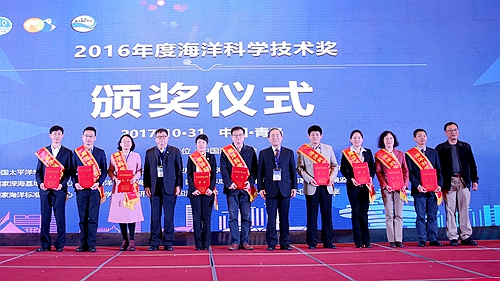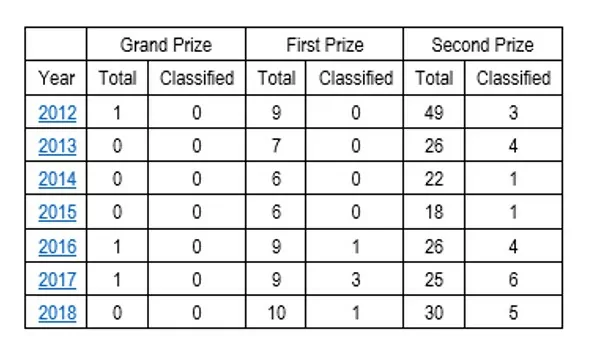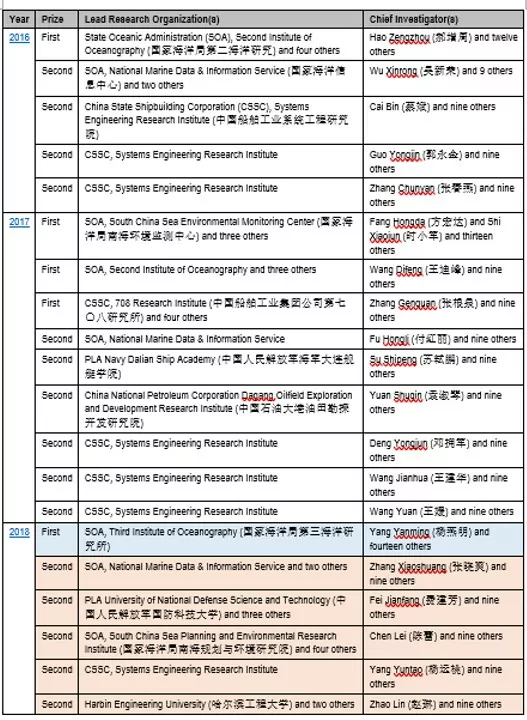
Assessing the Future of Chinese Sea Power: Insights from the “Marine Science and Technology Award”
Publication: China Brief Volume: 19 Issue: 2
By:

In late December, the Chinese press announced the 2018 winners of the “Marine Science and Technology Award” (MSTA), an annual prize recognizing China’s best work in oceanic research (China Ocean News, December 26 2018). For outside observers, the list of winners helps to identify pockets of excellence in Chinese marine science and technology. It also sheds light on Beijing’s current maritime intentions and future maritime capabilities—namely, where China is investing its resources, and which of its investments are panning out. Since 2016, award organizers have released limited information on winning “classified projects” (涉密项目), which are of special interest to those seeking to gauge China’s maritime ambitions. This article aggregates these data to identify the organizations and individuals at the forefront of strategically-important ocean research and development in China. It also explores how this information creates opportunities for more targeted analysis of individual Chinese maritime research projects.
Background on the MSTA
The Marine Science and Technology Award (海洋科学技术奖) recognizes Chinese “scientific and technological achievements that make breakthrough contributions” in the field of ocean research (Chinese Society for Oceanography, March 29 2013). Established in 2012, the award is organized by three scholarly associations: the Chinese Society for Oceanography, the Pacific Ocean Society of China, and the Chinese Society of Oceanology and Limnology. The MSTA is overseen by an award committee. The committee in turn selects an award jury, which is responsible for judging nominations. The jury comprises dozens of China’s top experts in marine science and technology (Chinese Society for Oceanography, December 16 2018). Office staff located within the Chinese Society for Oceanography serve to facilitate the six-month-long selection process.
The award recognizes outstanding work in both scientific research and the development of new products, equipment, materials, and techniques. It accepts nominations from a wide range of fields, ranging from environmental science to ocean resource exploration. The committee considers projects related to “support for maritime security” (海洋安全保障) and “defense of maritime rights and interests” (权益维护)—euphemisms for actions to assert China’s territorial claims in the East China Sea and South China Sea (Chinese Society for Oceanography, March 29 2013). Most, if not all, classified projects likely fall within these categories.
The award jury selects “first prize” (一等奖) and “second prize” (二等奖) winners. In some years, they also choose a single “grand prize” (特等奖). Aside from honor and recognition, winners receive modest cash awards. Table 1 shows total numbers of grand prizes, first prizes, and second prizes awarded since 2012, as well as the numbers of winning “classified” projects.
Table 1: Numbers of Winning Projects for Each Award Category (2012-2018)

Winning Classified Projects (2016-2018)
After award decisions are vetted by the award committee, the results are released to the public. Lists of award winners contain the name of the project, the nominating organization, the organization(s) involved in the project, and the chief scientists and engineers that completed the work. From 2012-2015, award announcements excluded any information about winning classified projects: instead, the phrases “secret project” (保密项) or “omitted” (略) were inserted as placeholders. This changed in 2016, when the award committee started providing the name of the nominating organization, the lead research organization, and the chief investigator for winning classified projects. Award announcements continued to omit the title of classified projects, using the character “secret” (密) as a placeholder. Table 2 aggregates the available information about winning classified projects since 2016.
Table 2: Awardees for Classified Projects (2016-2018)

Observations from the MSTA Data
Although limited, these data points do allow for some useful observations. Two organizations dominate the top tier of classified marine research and development work in the PRC: the State Oceanic Administration (SOA) and China State Shipbuilding Corporation (CSSC). Of the twenty award-winning classified projects since 2016, sixteen were led by research units or organizations affiliated with one of these two institutions. In the case of CSSC, the Systems Engineering Research Institute has been the leading awardee, winning seven of the eight awards granted to CSSC since 2016. SOA entities have also won eight total awards since 2016, with three going to the National Marine Data and Information Service; and the Second Institute of Oceanography earning two awards, both first-place. Of the five first-place awards given to classified projects since 2016, four went to SOA-led projects.
That CSSC is well-represented should come as no surprise: it is one of China’s two largest state-owned shipbuilding conglomerates, and it constructs the bulk of China’s warships and a range of other equipment for the People’s Liberation Army Navy (PLAN). CSSC’s Systems Engineering Research Institute oversees several key research groups—including the Ocean Smart Technology Innovation Center, which researches unmanned platforms (Xinhua, December 5 2017); and the Key Laboratory of Acoustic Warfare Technology (CSSC Systems Engineering Research Institute, undated).
For its part, SOA has long played an important role in strategically-important marine science. For example, the SOA Third Institute in Fujian publicly acknowledges that it conducts “military oceanography” and “projects for national defense construction” (China Ocean Online, October 3 2007). It and other parts of SOA have helped the PLAN strengthen its awareness of the ocean battlespace environment, both in the East Asian littorals and further afield. In January 2009, the institute signed a cooperative agreement with the PLAN that included pledges of support in marine science and technology; this relationship was further bolstered with a second agreement in April 2017 (China Maritime Studies Institute, November 2018).
One surprise takeaway from the data is that the Chinese Academy of Science (CAS) did not lead a single winning classified project in the 2016-2018 period. CAS ocean research institutes are among the country’s best. However, CAS appears to focus on building foundational knowledge, which others can then apply to the development of new military capabilities. In 2012, for example, several CAS research institutes completed a large unclassified study of the physical oceanography and acoustic properties of waters within the First Island China (i.e., the “near seas”). Directed by Hou Yiyun (侯一筠), a researcher at the CAS Institute of Oceanography, the project ultimately led to improvements in systems used by the Chinese military: the PLAN South Sea Fleet Center of Meteorology and Oceanography, for instance, applied the new knowledge to increase its ocean data assimilation capabilities and improve forecasting of oceanic conditions (e.g., waves, currents, temperature, salinity, etc.) (Shandong Province Department of Science and Technology, undated).
Other Insights from the MSTA
The information in Table 2 presents opportunities for further investigation into individual winning projects. For example, Yang Yanming (杨燕明), a researcher at SOA’s Third Institute of Oceanography, led a classified project that won a first-place prize in 2018. Yan is the Director of the Institute’s Laboratory of Ocean Acoustics and Remote Sensing (Harbin Engineering University, April 25 2016). His ties with the Chinese military are readily documented: a media profile shows that in 2009 he received an award from the PLA for undisclosed research (Optics Journal Online, undated). Recently, Yang’s acoustics research has focused on waters beyond the near seas: from July-September 2017 he participated in China’s 8th Arctic Marine Scientific Expedition, one of eleven researchers to do so from the Third Institute. Yang and two colleagues conducted experiments on underwater sound propagation in the Arctic Ocean (Third Institute of Oceanography, October 12 2017). Yang has also done work on “convergence zones”—ocean areas amenable to long-range submarine detection—in deep-sea areas east of the Luzon Strait (between Taiwan and the Philippines), the very waters that U.S. submarines must navigate when entering the South China Sea (Acta Oceanologica Sinica, July 2015).
Lists of award winners also provide a useful reference for U.S. researchers and research institutions considering engagement with Chinese counterparts. A review of past interactions suggests that U.S. interlocutors may not have been fully aware of the relationships between civilian oceanic research institutions and the PLA. The U.S. Naval Postgraduate School (NPS) is a case in point: its Department of Oceanography has sponsored visiting fellows from Chinese research institutes, such as the Second Institute of Oceanography (Second Institute, undated)—which the above data show to be a key center of classified marine science and technology research. NPS scholars have also travelled to China to share their expertise with Chinese researchers, some of whom work on classified projects. For instance, in November 2013 the director of the NPS Naval Ocean Analysis and Prediction Laboratory participated in a SOA-sponsored conference on ocean monitoring technologies, held in Zhejiang Province (China Argo, November 30 2013). Others present at the conference included researchers from the PLA Institute of Technology, PLA Unit 61741, the Second Institute of Oceanography, and the directors of three award-winning classified projects led by the National Marine Data & Information Service: Wu Xinrong, Fu Hongli, and Zhang Xiaoshuang (China Argo, November 29 2013).
Caveats and Conclusions
Although MSTA announcements provide some hints regarding state priorities for oceanic research, they may not identify all the leading persons and institutions in this field: for instance, some projects may be so highly classified that risks of exposure outweigh the benefits of public recognition. There is also the possibility that favoritism and bureaucratic patronage could skew the award results, and this very real possibility argues against attaching too much importance to rankings within and across each award class. Foreign analysts of Chinese maritime strategy should not simply dismiss the potential significance of projects that have not received the validation of a Marine Science and Technology Award. However, referring to lists of MSTA winners can serve to identify some of the more prominent Chinese institutions performing oceanic research, and may provide further avenues of research for scholars and others focused on the PRC’s naval and commercial maritime development.




